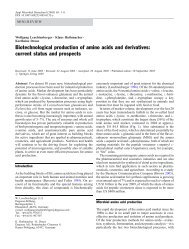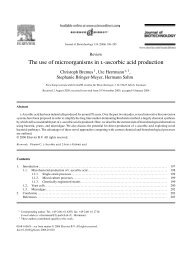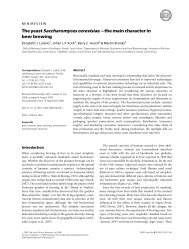The yeast Kluyveromyces marxianus and its ... - It works!
The yeast Kluyveromyces marxianus and its ... - It works!
The yeast Kluyveromyces marxianus and its ... - It works!
Create successful ePaper yourself
Turn your PDF publications into a flip-book with our unique Google optimized e-Paper software.
344 Appl Microbiol Biotechnol (2008) 79:339–354<br />
obtained directly from the main culture collections worldwide.<br />
If, on the one h<strong>and</strong>, this leads to an interesting<br />
metabolic diversity <strong>and</strong> to several potential applications, as<br />
described below in this review, it makes it difficult, on the<br />
other h<strong>and</strong>, to gain fundamental knowledge on the<br />
metabolism <strong>and</strong> physiology of this <strong>yeast</strong>. In this sense, it<br />
would be necessary that researchers started using a reduced<br />
number of strains (chosen from key culture collections),<br />
similarly to the way in which the K. lactis community has<br />
been using the CBS 2359 strain (Lachance 1998; Fukuhara<br />
2006). This would allow the development of efficient<br />
molecular genetic tools for K. <strong>marxianus</strong> (probably starting<br />
with genome sequencing), which are the basis for<br />
performing systematic studies that will finally lead to a<br />
better underst<strong>and</strong>ing of the biology of this species. A<br />
possibility would be to choose one or two strains with<br />
characteristics that have given K. <strong>marxianus</strong> a clear<br />
advantage over other <strong>yeast</strong>s: thermotolerance, high growth<br />
rate, absence of fermentative metabolism upon sugar<br />
excess, <strong>and</strong> a broad substrate spectrum. For making this<br />
choice, an approach as the one reported by van Dijken et al.<br />
(2000) could be followed.<br />
Recombinant DNA technology<br />
As with any (potential) industrial organism, rational genetic<br />
manipulation is one of the most efficient ways of<br />
optimizing process yield <strong>and</strong>/or productivity. In some cases,<br />
the application of recombinant DNA (rDNA) technology<br />
may even become a prerequisite for a successful industrial<br />
process, either to increase product titer <strong>and</strong>/or purity to<br />
levels at which the process becomes economically feasible<br />
or to render the producing host capable of synthesizing a<br />
heterologous compound. This kind of activity has been well<br />
known as metabolic engineering, which is now a consolidated<br />
discipline (Stephanopoulos et al. 1998). rDNA<br />
technology is also an invaluable technique for genetic <strong>and</strong><br />
physiological studies, which in turn are essential for<br />
increasing our underst<strong>and</strong>ing of K. <strong>marxianus</strong>.<br />
Already more than two decades ago, transformation<br />
methods for inserting foreign DNA into K. <strong>marxianus</strong> have<br />
been developed. Das et al. (1984) constructed a plasmid<br />
called pGL2, containing the kanamycin resistance gene as a<br />
dominant selectable marker, <strong>and</strong> the KARS2 autonomously<br />
replicating sequence of K. lactis. <strong>The</strong>y showed that the<br />
transformation method of intact cells with alkali cations,<br />
originally developed for Saccharomyces cerevisiae by <strong>It</strong>o et<br />
al. (1983), also worked in the strain K. fragilis C21.<br />
However, the transformation efficiency was rather low.<br />
A breakthrough in molecular biology research of<br />
<strong>Kluyveromyces</strong> <strong>yeast</strong>s was the discovery of the pKD1<br />
plasmid in the species <strong>Kluyveromyces</strong> drosophilarum<br />
(Falcone et al. 1986). <strong>The</strong> 4.8-kb, 1.65 μm pKD1 plasmid<br />
proved to have a similar organization but different<br />
sequences <strong>and</strong> host specificities, when compared to other<br />
already known plasmids, such as the 2 μ plasmid of<br />
Saccharomyces <strong>yeast</strong>s (Chen et al. 1986). In contrast to the<br />
latter, pKD1 can be maintained stable in K. lactis, but not in<br />
S. cerevisiae, in the absence of selective pressure (Bianchi<br />
et al. 1987). Later, it was shown that the insertion of the<br />
kanamycin resistance gene, the URA3 gene of S. cerevisiae,<br />
a replication origin for E. coli, <strong>and</strong> the ampicillin resistance<br />
gene into pKD1 rendered a shuttle plasmid that could be<br />
transformed <strong>and</strong> maintained in K. <strong>marxianus</strong> strains CBS<br />
6556 <strong>and</strong> CBS 712, though still with low-transformation<br />
efficiencies (Chen et al. 1989). This is in accordance with<br />
the fact that ARS <strong>and</strong> centromere sequences of K. lactis<br />
work in K. <strong>marxianus</strong> <strong>and</strong> vice versa (Das et al. 1984;<br />
Iborra <strong>and</strong> Ball 1994). Thus, pKD1-based plasmids have<br />
become the most common choice for inserting foreign<br />
DNA sequences into K. <strong>marxianus</strong> (Bergkamp et al. 1993b;<br />
Bartkevičiute et al. 2000; Zhang et al. 2003).<br />
Iborra (1993) reported for the first time transformation<br />
efficiencies in the order of hundreds to thous<strong>and</strong>s of<br />
transformants per microgram of DNA with K. <strong>marxianus</strong>,<br />
either with the lithium method (<strong>It</strong>o et al. 1983) or using<br />
electroporation (Meilhoc et al. 1990). Similar results were<br />
obtained more recently by Zhang et al. (2003).<br />
Besides requiring efficient vectors <strong>and</strong> transformation<br />
protocols, foreign gene expression also depends on the<br />
promoter <strong>and</strong> eventually a signal sequence for directing the<br />
synthesized protein into the extracellular environment,<br />
which usually facilitates downstream operations. For this<br />
purpose, Bergkamp et al. (1993a) used the promoter <strong>and</strong><br />
prepro-signal sequence of the INU1 (inulinase) gene to<br />
successfully direct heterologous expression <strong>and</strong> secretion of<br />
α-galactosidase in K. <strong>marxianus</strong>, with dramatically higher<br />
efficiencies when compared to the use of classical S.<br />
cerevisiae promoters, such as PGK.<br />
With the INU1 promoter, heterologous gene expression<br />
can be fine-tuned by choosing the appropriate carbon<br />
source. Another regulated promoter that was successfully<br />
used in K. <strong>marxianus</strong> is the tetracycline repressible<br />
promoter (Pecota <strong>and</strong> da Silva 2005).<br />
Strong, constitutive promoters for driving heterologous<br />
gene expression have also been described, such as that of a<br />
purine-cytosine permease gene (Ball et al. 1999). Instead of<br />
fine-tuning foreign gene expression according to promoter<br />
strength or induction properties, Pecota et al. (2007)<br />
developed an insertion cassette that enables multicopy<br />
integration of a precise number of gene copies into K.<br />
<strong>marxianus</strong> with recycling of the selection marker.<br />
Auxotrophic mutants of K. <strong>marxianus</strong>, for their use in<br />
transformation experiments, have been reported for leucine,<br />
uracil, histidine, or triptophane requirement (Bergkamp et





